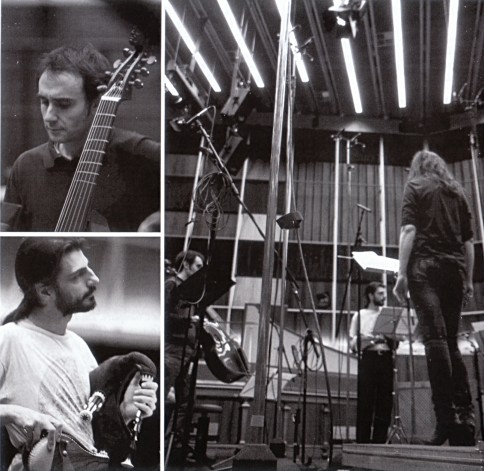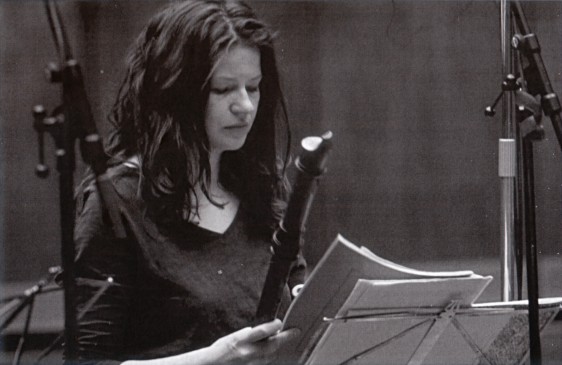 Dorothee Oberlinger (born 2 September 1969) is a German recorder player and professor.
Dorothee Oberlinger (born 2 September 1969) is a German recorder player and professor.
Biography
Dorothee Oberlinger was born in Aachen and raised in Simmern. At the University of Cologne, she studied music education and German studies. After university, she studied recorder in Cologne, Amsterdam and Milan. Her teachers include Günther Höller (Hochschule für Musik und Tanz Köln), Walter van Hauwe (Amsterdam) and Pedro Memelsdorff (Milan). In 1997 she won the first prize at the international “Moeck” UK / SRP competition. In 1998, she made her solo debut at London’s Wigmore Hall.

As a soloist, she has performed with internationally renowned ensembles and baroque orchestras, such as the Sonatori de la Gioiosa Marca, Musica Antiqua Köln, and the Academy of Ancient Music. In 2002, she founded the chamber group Ensemble 1700.[2] They have received several prizes and awards for their recordings[3]
Since 2004, Oberlinger has been professor at the Mozarteum in Salzburg and director of the Institute for Early Music and first deputy director of the Institute for New Music.[4] Since 2009, she has also been director of Arolser Baroque Festival. (wikipedia)

Dorothee Oberlinger’s CD is devoted entirely to the French Baroque. The recorder player, who lives in Cologne, is a star of the early music scene. For her last CD “Recorder Concerts” she received hymn-like reviews not only in the specialist press. The KulturSpiegel wrote: “Pearls from the Baroque Ocean. A discovery tour for gourmets.” Then in spring Oberlinger surprised everyone by appearing on the new CD “Touch Yello” by the Swiss pop band Yello. On “French Baroque” Oberlinger presents a selection from the chamber music of the most important French court musicians such as Hotteterre, Chedeville, Marais or Couperin – from the time of Louis XIV to the era of Louis XV. Contemplative music for intimate occasions is juxtaposed here with pleasing trios and entertaining “musique champetre” (rural music), whose stylised folksiness was the expression of an idyllic utopia of the nobility of the time. (press release)

Whereas in the last decades of the 17th century the conflict between the traditional French and the modern Italian style was one of the main features of music life in France, after the turn of the century the stranglehold of the traditionalists came to an end. Composers felt free to follow their ideal of mixing the best of two worlds, and the result was an amalgam of styles and scorings. This disc with music written between 1700 and 1740 offers some insight into the musical developments at that time.
A second development had a considerable impact upon the evolution of music: the emergence of public concerts. The most famous concert series was the Concert Spirituel, where some of the best music was performed. That not only included music by the main composers from France, but also music by Italian masters. Vivaldi’s concertos were particularly popular, and his famous Four Seasons were performed several times.

Nicholas Chédeville made use of this, as he published some of his own compositions under Vivaldi’s name. He also arranged Vivaldi’s opus 8, including the Four Seasons, for musette or hurdy-gurdy, violin, transverse flute and bc. This disc contains extracts from two of these concertos. The musette was a popular instrument in France, representing the countryside. In her liner-notes Dorothee Oberlinger explains this: “The French aristocracy longed for a secluded idyll, for a simple, natural world far removed from that of rigid courtly ceremonial; this idyll imitated what they believed to be the plain and carefree life of country folk”. This is reflected in pieces like the Rondeau Le Champêtre by Jacques-Martin Hotteterre, the suite La Noce Champêtre ou l’Himen pastoral by his elder brother Jean, depicting a wedding at the countryside, but also by many character pieces in François Couperin’s harpsichord music. One specimen is Le Rossignol-en-amour, which according to Couperin could also be played at the flute.

He almost certainly referred to the transverse flute, and that is also the instrument which played a central role at the music scene in the first half of the 18th century. From that perspective the choice to play all flute parts on the recorder is questionable. The recorder hadn’t completely disappeared: it was still played, and Hotteterre’s Prélude in g minor was even specifically written for it. And there is certainly no reason to exclude the recorder in performances of French music of this time. In some cases the recorder is not the most logical choice, though, and that is particularly the case with the Concerto in a minor by Michel Blavet. He was a brilliant player of the transverse flute, and recognized as such by, for instance, Johann Joachim Quantz, who visited Paris and heard him play. The concerto reflects his skills, and its character is rather at odds with the limited possibilities of the recorder. The performance by Brian Berryman on a recent disc around Quantz is more convincing and does more justice to the brilliance of the solo part.
The recorder is more suitable for the Trio in a minor, op. 37,5 by Joseph Bodin de Boismortier. He composed for about any instrument in vogue in his time, and in several collections the recorder is mentioned as one of the options. The opus 37 consists of trio sonatas for one treble instrument, a bass instrument and basso continuo. The same is true for the Sonata in d minor by Anne Danican Philidor, who founded the Concert Spirituel in 1725.

Like the Hotteterre’s the Philidor’s were a musical dynasty which played an important role in music life. Anne Danican was oboist, and at that time oboists also played the recorder. In the small number of instrumental works from his pen which have survived he gave the performers the option of choosing almost any treble instrument to play the upper parts. In the foreword of his Couplets de Folie Marin Marais specifically permitted performances on other instruments than the viola da gamba, for which they were originally intended. Only some of the variations are played here.
That is one of the features of this disc. Three movements from Les Saisons Amusantes by Chédeville are played, and these are extracts from two different concertos. The last piece of the programme, the Chaconne in D by Antoine Dornel, is also taken from a larger work: the Suite in D from the opus 1 of 1709. Jean Hotteterre’s La Noce Champêtre was originally written for musette and bc.

Here the upper parts are shared by recorder and musette, and even a second part has been added. I don’t see the need for this nor do I believe this is an improvement of what the composer has written down.
One may conclude that this disc has some flaws: questionable scorings, unnecessary arrangements, chopping up of pieces. The performances don’t fall into that category, though: Dorothee Oberlinger is a brilliant recorder player who performs with energy and imagination on nine different recorders. The playing of the ensemble is of the same calibre. And the quality and variety of the repertoire is such that it is impossible to get bored. Nobody interested in French baroque music and recorder aficionados shouldn’t hesitate to purchase this disc. (Johan van Veen)

Personnel:
Lorenzo Alpert (bassoon)
Thomas Boysen (guitar, theorbo)
Florian Deuter (violin)
Vittorio Ghielmi (viol)
Angela Koppenwallner (organ)
François Lazarevitch (flute. musette, voice)
Michael Niesemann (oboe)
Dorothee Oberlinger (recorder)
Rodney Prada (viol)
Alexander Puliaev (harpsichord)
Mónica Waisman (violin)
Conducted by Dorothee Oberlinger

Tracklist:
Michel Blavet – Concert In A Minor (Recorder, 2 Violins & Continuo):
01. Allegro 5.38
02. Gavotte I & II 3.44
03. Allegro 4.50
Jean Hotteterre – La Noce Champêtre Ou L’Himen Pastoral (Dessus I & II & Continuo):
04. Prélude: Appel Pour Rassembler La Troupe 1.27
05. Sarabande L’Himen 3.25
06. Ouverture (Le Festin) 2.38
07. Menuet 1 & 2, Contredanse, Cotillon 3.19
08. Le Coucher. Le Réveil Matin 3.05
Jacques Martin Hotteterre:
09. Prélude In G Minor 3.16
Joseph Bodin de Boismortier – Trio In A Minor Op. 37, No. 5:
10. Vivace 2.14
11. Largo 1.25
12. Allegro 1.46
Nicolas Chédeville – From “Les Saisons Amusantes”:
13. Allegro From Concerto No. 1 “Le Printemps” (after Vivaldi) (Recorder, Violin, Musette & Continuo) 3.07
14. Largo From Concerto No. 2 “Les Plaisiers De L’Etè” (after Vivaldi) (Recorder, Violin, Musette & Continuo) 2.33
15. Allegro (La Caccia) From Concerto No. 2 “Les Plaisiers De L’Etè” (after Vivaldi) (Recorder, Violin, Musette & Continuo) 3.24
Robert De Visée:
16. Prélude In G Major (Theorbo Solo) 0.53
François Couperin:
17. Le Rossignol En Amour (Recorder & Continuo) 3.13
Marin Marais:
18. Couplets De Folie (Extract) (Recorder Solo) 4.57
Anne Danican Philidor – Sonata In D Minor (Recorder & Continuo):
19. Lentement 2.29
20. Fugue 1.11
21. Courante 1.14
22. Gracieusement 1.16
23. Fugue 1.31
Jacques Martin Hotteterre:
24. Les Delices, Ou Le Fargis 2.48
25. Rondeau, Le Champêtre, Les Ecos (Recorder, Traverso & Continuo) 2.01
Antoine Dornel:
26. Chaconne In D Major (Dessus I & II And Continuo) 3.58



The official website:

